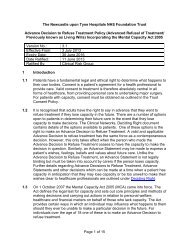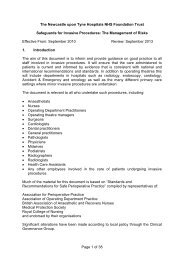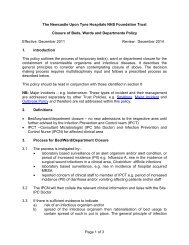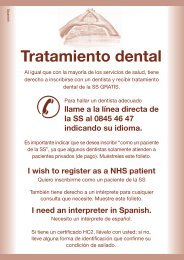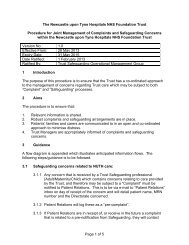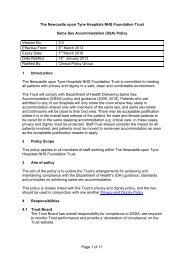Implementation Policy for NICE Guidelines - Newcastle Hospitals
Implementation Policy for NICE Guidelines - Newcastle Hospitals
Implementation Policy for NICE Guidelines - Newcastle Hospitals
You also want an ePaper? Increase the reach of your titles
YUMPU automatically turns print PDFs into web optimized ePapers that Google loves.
The <strong>Newcastle</strong> upon Tyne <strong>Hospitals</strong> NHS Foundation Trust<br />
<strong>Implementation</strong> <strong>Policy</strong> <strong>for</strong> <strong>NICE</strong> <strong>Guidelines</strong><br />
Version No.: 5.1<br />
Effective From: 17 th January 2013<br />
Expiry Date: 31 st December 2015<br />
Date Ratified: 17 th January 2013<br />
Ratified By: Clinical Effectiveness Audit and <strong>Guidelines</strong> Committee<br />
1. Introduction<br />
The <strong>Policy</strong> sets out the procedures to be followed throughout the Trust to monitor the<br />
implementation of guidance published by the National Institute <strong>for</strong> Health and Clinical<br />
Excellence (<strong>NICE</strong>).<br />
2. Scope<br />
This policy is intended <strong>for</strong> all Trust staff involved with the implementation of <strong>NICE</strong><br />
guidance. It should be read in conjunction with the Clinical Audit <strong>Policy</strong> and Clinical<br />
Practice <strong>Guidelines</strong> & Protocols policy.<br />
The policy covers all guidelines issued by <strong>NICE</strong>: Technology Appraisals (TAGs),<br />
Interventional Procedures (IPGs), Clinical <strong>Guidelines</strong> (CGs), Public Health<br />
Interventional guidelines (PHIs), Medical Technology <strong>Guidelines</strong> (MTGs), Diagnostic<br />
<strong>Guidelines</strong> (DTGs), Quality Standards (QSs) and Guidance <strong>for</strong> Cancer Services:<br />
Improvement Outcomes Guidance (IOGs).<br />
3. Aims<br />
The <strong>Policy</strong> aims to ensure that all recommendations from <strong>NICE</strong> are considered by<br />
the appropriate area(s) within the Trust and that any mandatory recommendations<br />
are implemented in a timely and effective manner. It sets out the processes to be<br />
followed, the roles and responsibilities involved and the escalation processes <strong>for</strong><br />
areas of risk.<br />
4. Roles and Responsibilities<br />
4.1 Medical Director<br />
Ultimately, responsibility <strong>for</strong> the implementation of <strong>NICE</strong> guidance rests with<br />
the Medical Director who maintains an overview of the implementation of<br />
<strong>NICE</strong> guidance and provides advice and guidance in relation to <strong>NICE</strong><br />
guidance in which the Trust is non-compliant.<br />
4.2 Clinical Governance and Risk Department<br />
The Department coordinates the implementation of <strong>NICE</strong> guidance by:<br />
• disseminating guidance to key groups<br />
Page 1 of 10
• reviewing and in<strong>for</strong>ming stakeholders of prospective guidance<br />
being issued from <strong>NICE</strong><br />
• ensuring effective processes <strong>for</strong> monitoring<br />
• producing regular board reports.<br />
4.3 Clinical Effectiveness, Audit and <strong>Guidelines</strong> Committee (CEAGC)<br />
The Clinical Effectiveness, Audit and <strong>Guidelines</strong> Committee (CEAGC)<br />
considers all new guidance issued by <strong>NICE</strong> to ensure:<br />
• effective audit and monitoring arrangements are in place<br />
• effective <strong>for</strong>ward planning occurs and appropriate financial<br />
arrangements are in place<br />
• that the Clinical Governance and Quality Committee is notified of<br />
any issues concerning non-compliance.<br />
5. Definitions<br />
5.1 TAGs are recommendations on the use of new and existing health<br />
technologies. As stated in the <strong>NICE</strong> publication “How to put <strong>NICE</strong> guidance<br />
into practice – a guide to implementation <strong>for</strong> organisations” (<strong>NICE</strong> 2005), the<br />
Secretary of State has directed that the NHS provides funding and resources<br />
<strong>for</strong> medicines and treatments that have been recommended by TAGs<br />
normally within three months from the date of publication.<br />
5.2 IPGs cover the safety and efficacy of surgical and diagnostic procedures with<br />
the core standard stating that healthcare organisations should protect patients<br />
by following <strong>NICE</strong> IPGs.<br />
5.3 CGs provide guidance on the appropriate treatment and care of people with<br />
specific diseases and conditions. <strong>Implementation</strong> of Clinical <strong>Guidelines</strong> <strong>for</strong>ms<br />
part of the Care Quality Commission developmental standards.<br />
5.4 PHIs provide guidance on the promotion of good health and the prevention of<br />
ill health.<br />
5.5 DTGs are designed to help the NHS adopt efficient and cost effective medical<br />
diagnostic technologies more rapidly and consistently.<br />
5.6 MTGs are designed to help the NHS adopt efficient and cost effective medical<br />
devices and diagnostics more rapidly and consistently, such as medical<br />
devices that deliver treatment such as those implanted during surgical<br />
procedures, technologies that give greater independence to patients, and<br />
diagnostic devices or tests used to detect or monitor medical conditions.<br />
5.7 Quality Standards are a set of specific, concise statements and associated<br />
measures. They set out aspirational, but achievable, markers of high-quality,<br />
cost-effective patient care, covering the treatment and prevention of different<br />
diseases and conditions.<br />
Page 2 of 10
6. <strong>Implementation</strong> of <strong>NICE</strong> Guidance<br />
6.1 The Trust approach to the implementation of <strong>NICE</strong> guidance follows the<br />
principles set out in the <strong>NICE</strong> publication “How to put <strong>NICE</strong> guidance into<br />
practice – a guide to implementation <strong>for</strong> organisations” (<strong>NICE</strong>, 2005) with<br />
particular reference to the following key components:<br />
• board support and clear leadership<br />
• support from Clinical Governance and Risk Department to<br />
coordinate the process<br />
• multidisciplinary committee structure to consider all new<br />
guidance<br />
• systematic approach to financial planning<br />
• systematic approach to implementing guidance<br />
• evaluation and audit.<br />
6.2 Systematic approach to financial planning<br />
The Trust recognises the importance of clear financial planning in<br />
implementing <strong>NICE</strong> guidance. This is in accordance with the Audit<br />
Commission’s report “Managing of the financial implications of <strong>NICE</strong><br />
guidance” (September 2005). In particular, the implications of Payment by<br />
Results on funding of <strong>NICE</strong> recommendations must be clearly understood.<br />
The CEAGC seek clarification and assurances that appropriate assessments<br />
have been made by Directorates.<br />
6.3 Systematic approach to implementing guidance<br />
TAGs<br />
• The process <strong>for</strong> ensuring that recommendations are acted upon<br />
throughout the Trust are set out in Appendix 1.<br />
• Appendix 2 details the additional arrangements <strong>for</strong> drug-related TAGs.<br />
IPGs<br />
• Where a Directorate indicates that an IPG is applicable within the Trust,<br />
the process <strong>for</strong> ensuring that recommendations are acted upon<br />
throughout the Trust are set out in Appendix 3.<br />
• Any doctor considering use in the NHS of a new interventional<br />
procedure which he/she has not used be<strong>for</strong>e, or only used outside the<br />
NHS, should seek the prior approval of the Clinical Governance and<br />
Quality Committee using the New Interventional Procedure <strong>for</strong>m<br />
available on the Trust intranet. They should state whether the<br />
procedure is the subject of <strong>NICE</strong> guidance as listed on the <strong>NICE</strong><br />
website. If it is, the Committee will consider whether the proposed use<br />
of the procedure complies with the guidance be<strong>for</strong>e approving it.<br />
Page 3 of 10
• If an IPG is not being currently used, but may be used in the future,<br />
then at the time of introduction, the lead clinician must ensure that it is<br />
discussed at the Clinical Governance and Quality Committee, and<br />
thereafter in<strong>for</strong>m the Clinical Governance and Risk Department<br />
CGs<br />
• The implementation process <strong>for</strong> CGs, DTGs and MTGs is identified in<br />
Appendix 4.<br />
PHIs<br />
• The implementation process <strong>for</strong> PHIs is identified in Appendix 5<br />
Quality Standards<br />
• The implementation process <strong>for</strong> QSs is identified in Appendix 4<br />
IOGs<br />
• The <strong>Implementation</strong> of IOGs is coordinated by cancer networks working<br />
in collaboration with partner organisations.<br />
• Each organisation undertakes a gap analysis, <strong>for</strong> the Trust this is lead<br />
by the Cancer team. Key stakeholders meet with the network to devise<br />
a plan which goes to the Department of health with appropriate<br />
timescales <strong>for</strong> implementation.<br />
• It is important that representatives of the Trust at Network level<br />
communicate with the relevant Clinical Director / Directorate Managers<br />
and with the Trust’s Cancer team with regards to the implementation of<br />
any action plan be<strong>for</strong>e that plan is passed to the Network <strong>for</strong> approval.<br />
6.4 Deviance from <strong>NICE</strong> Guidance<br />
Where the lead clinician(s) <strong>for</strong> a specific guideline consider it to be<br />
inappropriate to follow the recommendations of <strong>NICE</strong>, e.g. the evidence base<br />
from which the recommendations are derived is considered to be insufficiently<br />
robust, it is essential that appropriate discussions are held within the Clinical<br />
Effectiveness, Audit and <strong>Guidelines</strong> Committee. The Committee will appraise<br />
the arguments be<strong>for</strong>e confirming or declining its support <strong>for</strong> the deviance from<br />
the guideline. Any deviances will be notified to the Chair, Clinical Governance<br />
and Quality Committee through the minutes of the Clinical Effectiveness, Audit<br />
and <strong>Guidelines</strong> Committee and entered on to the Risk Register.<br />
7. Training<br />
There are no specific training requirements identified <strong>for</strong> this policy.<br />
8. Equality and diversity<br />
The Trust is committed to ensuring that, as far as is reasonably practicable, the way<br />
we provide services to the public and the way we treat our staff reflects their<br />
Page 4 of 10
individual needs and does not discriminate against individuals or groups on any<br />
grounds. This document has been appropriately assessed.<br />
9. Monitoring<br />
Standard / process / issue<br />
• Each <strong>NICE</strong> Guideline<br />
Lead clinician to provide<br />
in<strong>for</strong>mation on<br />
implementation of the<br />
respective guideline within<br />
the Trust<br />
• Any identified deficiencies<br />
in gap analysis to be<br />
included on the Risk<br />
Register<br />
Monitoring and audit<br />
Method By Committee Frequency<br />
Six monthly report<br />
showing <strong>NICE</strong><br />
implementation<br />
statistics<br />
Status Report<br />
Clinical<br />
Effectiveness<br />
Manager<br />
Clinical<br />
Effectiveness<br />
Manager<br />
CEAGC<br />
CEAGC<br />
Six monthly<br />
Quarterly<br />
• Progress on the<br />
implementation of and<br />
compliance with <strong>NICE</strong><br />
guidelines<br />
Status Report<br />
Clinical<br />
Effectiveness<br />
Manager<br />
Trust Board<br />
Six monthly<br />
10. Consultation and review<br />
The processes in this policy have been reviewed and agreed by Pharmacy, Finance,<br />
Clinicians and the Clinical Effectiveness, Audit and <strong>Guidelines</strong> Committee.<br />
11. <strong>Implementation</strong> (including raising awareness)<br />
In<strong>for</strong>mation about <strong>NICE</strong> guidelines, the implementation processes and the <strong>for</strong>ms to<br />
be completed are available on the Trust’s intranet pages. All new <strong>NICE</strong> <strong>Guidelines</strong><br />
are published in the Quarterly Clinical <strong>Guidelines</strong> Newsletter produced by CGARD.<br />
12. References<br />
• Audit Commission. (September 2005) Managing the financial implications of<br />
<strong>NICE</strong> guidance. London: Audit Commission<br />
• Department of Health (September 1997a) The NHS Plan. London:<br />
Department of Health.<br />
• Department of Health (December 1997b) The New NHS: modern,<br />
dependable. London: Department of Health<br />
• Department of Health (July 1998) A First Class service: Quality in the new<br />
NHS. London: Department of Health<br />
• National Institute <strong>for</strong> Health and Clinical Excellence (December 2005) How to<br />
put <strong>NICE</strong> guidance into practice: A guide to implementation <strong>for</strong> organisations<br />
London: National Institute <strong>for</strong> Health and Clinical Excellence<br />
• The <strong>Newcastle</strong> Upon Tyne <strong>Hospitals</strong> NHS Foundation Trust Clinical Audit<br />
<strong>Policy</strong><br />
• The <strong>Newcastle</strong> Upon Tyne <strong>Hospitals</strong> NHS Foundation Trust Clinical Practice<br />
<strong>Guidelines</strong> & Protocols <strong>Policy</strong><br />
Page 5 of 10
Appendix 1<br />
Flow chart <strong>for</strong> Implementing Technology Appraisal <strong>Guidelines</strong><br />
<strong>NICE</strong> guidance<br />
published monthly<br />
Received in CGARD and posted on Clinical<br />
<strong>Guidelines</strong> Database<br />
* Directorate<br />
Manager/Lead Clinician<br />
responsible <strong>for</strong><br />
disseminating the<br />
guidelines to colleagues<br />
CGARD send guidelines to relevant<br />
Directorate Manager/Lead Clinician<br />
Documented in<br />
CEAGC minutes<br />
and no further<br />
NO<br />
(For reference)<br />
*Lead<br />
Clinician to<br />
identify if<br />
guidance is<br />
relevant<br />
YES<br />
(Endorsed)<br />
YES<br />
(Endorsed)<br />
CGARD record status on Trust Clinical<br />
<strong>Guidelines</strong> Database<br />
Drug-related TAG goes to North of<br />
Tyne Area Prescribing Committee<br />
<strong>for</strong> ratification see Appendix 2<br />
Non - Drug<br />
TAG<br />
Lead Clinician undertakes gap analysis<br />
Review of gap analysis are presented to<br />
Clinical Effectiveness, Audit and<br />
<strong>Guidelines</strong> Committee. (CEAGC)<br />
Report filed <strong>for</strong><br />
reference and<br />
monitoring<br />
NO<br />
Are there any<br />
stated areas<br />
of noncompliance<br />
YES<br />
Risks should be registered on the Risk<br />
Register. Risks rated moderate or above<br />
wil be monitored on quarterly basis<br />
by CEAGC.<br />
Three months to provide funding<br />
Page 6 of 10
Appendix 2<br />
Additional arrangements <strong>for</strong> drug-related Technology Appraisal <strong>Guidelines</strong> (TAGs)<br />
<strong>NICE</strong><br />
Publish TAG<br />
APC (Area Prescribing<br />
Committee) / NECDAG<br />
(North East and Cumbria<br />
Drugs Approval Group) <strong>for</strong><br />
ratification / interpretation<br />
Monitoring<br />
Medicines Management Unit<br />
Cost of implementation<br />
< 50K<br />
> 50K<br />
To Strategy Panel<br />
<strong>for</strong> Funding<br />
Approval<br />
To Trust Board<br />
<strong>for</strong> Funding<br />
Approval<br />
Page 7 of 10
Appendix 3<br />
Flow chart <strong>for</strong> Implementing Interventional Procedure <strong>Guidelines</strong><br />
<strong>NICE</strong> guidance<br />
published monthly<br />
* Directorate<br />
Manager/Lead Clinician<br />
responsible <strong>for</strong><br />
disseminating the<br />
guidelines to colleagues<br />
Received in CGARD and posted on Clinical<br />
<strong>Guidelines</strong> Database<br />
CGARD send guidelines to relevant<br />
Directorate Manager/Lead Clinician<br />
Directorate Manager/Lead Clinician to<br />
advise whether guideline in undertaken<br />
within the Trust<br />
No further action<br />
required<br />
Not undertaken<br />
(For reference)<br />
Status reported to<br />
Clinical Effectiveness,<br />
Audit and <strong>Guidelines</strong><br />
Committee and status<br />
recorded on Trust<br />
<strong>Guidelines</strong> Database<br />
YES already<br />
undertaken<br />
(Endorsed)<br />
No further action<br />
required<br />
Not undertaken but<br />
Lead Clinician wishes<br />
to commence<br />
undertaking procedure<br />
Lead Clinician applies to Clinical<br />
Governance and Quality Committee to<br />
undertake procedure<br />
Lead Clinician in<strong>for</strong>med of Committee<br />
decision<br />
CGARD revise status to Endorsed<br />
Page 8 of 10
Appendix 4<br />
Flow chart <strong>for</strong> Implementing <strong>NICE</strong> guidance and Quality Standards<br />
(this does not include TAGs and IPGs)<br />
<strong>NICE</strong> guidance<br />
published<br />
* Directorate<br />
Manager/Lead clinical<br />
responsible <strong>for</strong><br />
disseminating the<br />
guidelines to colleagues<br />
Received in CGARD and<br />
posted on Clinical<br />
<strong>Guidelines</strong> Database<br />
CGARD send guidelines to<br />
respective Directorate<br />
No further<br />
action<br />
required<br />
NO<br />
(For<br />
reference)<br />
* Lead<br />
Clinician to<br />
identify if<br />
Guideline is<br />
relevant<br />
YES<br />
(Endorsed)<br />
Lead Clinician undertakes<br />
gap analysis<br />
Lead Clinician attends Clinical<br />
Effectiveness, Audit & <strong>Guidelines</strong><br />
Committee (CEAGC) to discuss<br />
implementation and gap analysis<br />
Report filed<br />
<strong>for</strong><br />
reference,<br />
NO<br />
Are there any<br />
stated areas<br />
of noncompliance<br />
YES<br />
Risks should be registered on the Risk<br />
Register. Risks rated moderate or above<br />
wil be monitored on quarterly basis by CEAGC.<br />
Page 9 of 10
Appendix 5<br />
Flow chart <strong>for</strong> Implementing Public Health Interventional <strong>Guidelines</strong><br />
<strong>NICE</strong> guidance<br />
published<br />
Received in CGARD and<br />
posted on Clinical<br />
<strong>Guidelines</strong> Database<br />
CGARD send guidelines to an<br />
identified Lead Clinician<br />
No further<br />
action<br />
required<br />
NO<br />
(For<br />
reference)<br />
* Lead<br />
Clinician to<br />
identify if<br />
Guideline is<br />
relevant<br />
YES<br />
(Endorsed)<br />
Lead Clinician undertakes<br />
gap analysis<br />
Lead Clinician attends CEAGC to<br />
discuss implementation and gap<br />
analysis<br />
Report filed<br />
<strong>for</strong><br />
reference,<br />
NO<br />
Are there<br />
areas of noncompliance<br />
YES<br />
Refer to<br />
Trust Public Health<br />
Group<br />
Page 10 of 10
THE NEWCASTLE UPON TYNE HOSPITALS NHS FOUNDATION TRUST<br />
IMPACT ASSESSMENT – SCREENING FORM A<br />
This <strong>for</strong>m must be completed and attached to any procedural document when submitted to the appropriate committee <strong>for</strong> consideration and approval.<br />
<strong>Policy</strong> Title: <strong>Implementation</strong> <strong>Policy</strong> <strong>for</strong> <strong>NICE</strong> <strong>Guidelines</strong> <strong>Policy</strong> Author: Bernadette Risebury, In<strong>for</strong>mation Systems Analyst<br />
Yes/No You must provide evidence to support your response:<br />
1. Does the policy/guidance affect one group less or more favourably than another on<br />
the basis of the following: (* denotes protected characteristics under the Equality<br />
Act 2010)<br />
• Race * No<br />
• Ethnic origins (including gypsies and travellers) No<br />
• Nationality No<br />
• Gender * No<br />
• Culture No<br />
• Religion or belief * No<br />
• Sexual orientation including lesbian, gay and bisexual people * No<br />
• Age * No<br />
• Disability – learning difficulties, physical disability, sensory impairment and<br />
mental health problems *<br />
No<br />
• Gender reassignment * No<br />
• Marriage and civil partnership * No<br />
2. Is there any evidence that some groups are affected differently No<br />
3. If you have identified potential discrimination which can include associative<br />
discrimination i.e. direct discrimination against someone because they associate<br />
with another person who possesses a protected characteristic, are any exceptions<br />
N/A<br />
valid, legal and/or justifiable<br />
4(a).<br />
Is the impact of the policy/guidance likely to be negative<br />
(If “yes”, please answer sections 4(b) to 4(d)).<br />
N/A<br />
4(b). If so can the impact be avoided N/A<br />
4(c). What alternatives are there to achieving the policy/guidance without the impact N/A<br />
4(d) Can we reduce the impact by taking different action N/A<br />
Comments:<br />
Action Plan due (or Not Applicable): N/A<br />
Name and Designation of Person responsible <strong>for</strong> completion of this <strong>for</strong>m: Bernadette Risebury, In<strong>for</strong>mation Systems Analyst Date: 17/01/2013<br />
Names & Designations of those involved in the impact assessment screening process: Clinical Effectiveness Audit and <strong>Guidelines</strong> Committee<br />
(If any reader of this procedural document identifies a potential discriminatory impact that has not been identified on this <strong>for</strong>m, please refer to the <strong>Policy</strong> Author identified above, together<br />
with any suggestions <strong>for</strong> the actions required to avoid/reduce this impact.)<br />
For advice on answering the above questions please contact Frances Blackburn, Head of Nursing, Freeman/Walkergate, or, Christine Holland, Senior HR Manager. On completion this <strong>for</strong>m must be <strong>for</strong>warded<br />
electronically to Steven Stoker, Clinical Effectiveness Manager, (Ext. 24963) steven.stoker@nuth.nhs.uk together with the procedural document. If you have identified a potential discriminatory impact of this<br />
procedural document, please ensure that you arrange <strong>for</strong> a full cons ultation, with relevant stakeholders, to com plete a Full Im pact Assessment (Form B) and to develop an Action Plan to avoid/reduce this<br />
impact; both Form B and the Action Plan should also be sent electronically to Steven Stoker within six weeks of the completion of this <strong>for</strong>m.<br />
IMPACT ASSESSMENT FORM A October 2010


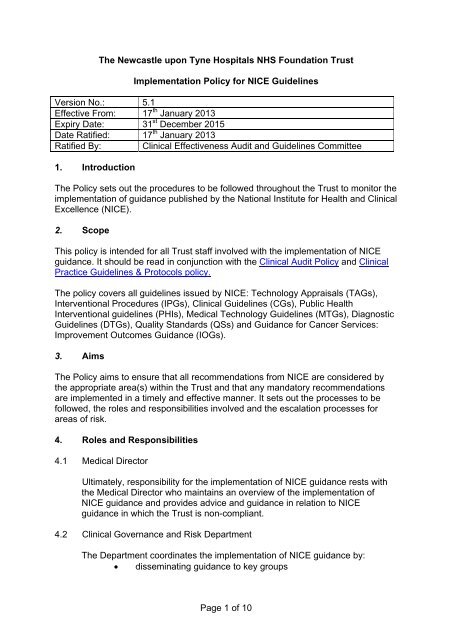
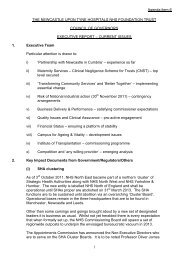
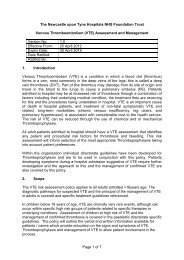
![Standard Precautions Policy - 112KB [PDF] - Newcastle Hospitals](https://img.yumpu.com/51150129/1/184x260/standard-precautions-policy-112kb-pdf-newcastle-hospitals.jpg?quality=85)
![Oxygen Management Policy - 38KB [PDF] - Newcastle Hospitals](https://img.yumpu.com/50798872/1/184x260/oxygen-management-policy-38kb-pdf-newcastle-hospitals.jpg?quality=85)
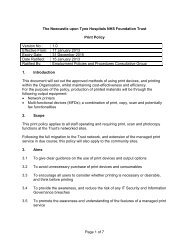
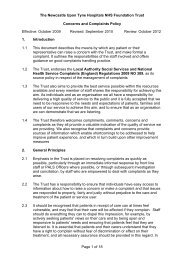
![Patient Identification Policy - 130KB [PDF] - Newcastle Hospitals](https://img.yumpu.com/49156101/1/190x245/patient-identification-policy-130kb-pdf-newcastle-hospitals.jpg?quality=85)
